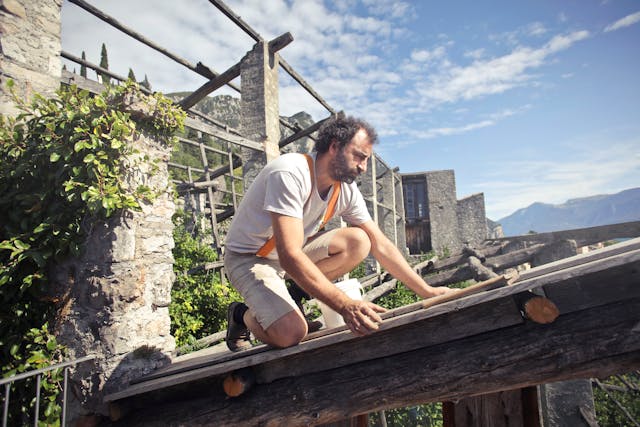A leaky roof can cause major damage to your home, often leading to costly repairs and potential health hazards. Whether it’s a small drip or a significant water intrusion, addressing roof leaks promptly is crucial to maintaining the integrity of your property. Fortunately, with the proper knowledge and techniques, you can effectively stop roof leaks and protect your home from water damage. This article will explore six pro tips to help you identify and fix roof leaks, way before they escalate into more significant problems.
Seal Flashing and Vents
Flashing and vents are vulnerable points on the roof where leaks are prone. Flashing, typically made of metal or rubber, seals joints and transitions between roof parts, such as around chimneys, skylights, and vents. Over time, flashing deteriorates due to exposure to weather and temperature fluctuations, allowing water to infiltrate the roof. Inspect the flashing regularly and replace any damaged or corroded sections.
Use roofing sealant to reinforce the seals around vents and other penetrations to prevent water from entering the attic. There are also sealants for leak prevention specifically designed for extreme weather conditions and provide long-lasting protection against leaks. When applying sealant, ensure the area is clean and dry to promote proper adhesion and effectiveness. Additionally, consider using flashing tape or self-adhesive flashing membrane to reinforce areas prone to leaks. By sealing flashing and vents proactively, you can effectively safeguard your roof against water intrusion and prolong its lifespan, ensuring a dry and comfortable interior for years to come.
Apply Roof Coatings
Roof coatings provide another layer of protection against water intrusion, extending the lifespan of your roof. These coatings are usually applied as a liquid membrane that adheres to the roof’s surface, forming a seamless barrier against moisture. Roof coatings can help seal small cracks and gaps in the roofing material, preventing leaks from developing. They also reflect sunlight and reduce heat absorption, which can help lower energy costs and prolong the roof’s life. Choose a high-quality coating compatible with your roofing material and climate conditions for the best results.
Clean and Maintain Gutters
Clogged gutters contribute to roof leaks by preventing proper drainage of rainwater from the roof. Leaves accumulate in the gutters over time, causing water to overflow and seep under the shingles. To prevent this problem, regularly clean your gutters, especially when leaves are shedding in the fall. Use a gutter scoop or trowel, remove debris, and rinse the gutters with a hose to ensure proper drainage. Additionally, install gutter guards, preventing debris from accumulating and clogging the gutters in the future.
Conduct Regular Inspections
Regular roof inspections help identify and address potential leaks before they worsen. Schedule inspections twice a year to assess your roof’s condition. During the inspection, look for signs of missing or damaged shingles, cracked flashing, and clogged gutters. Pay attention to areas where water is likely to accumulate, such as valleys, eaves, and around chimneys and vents. By catching problems early, you can prevent minor issues from escalating into significant leaks. Regular roof inspections help prevent water damage and ensure the longevity of your roof, providing peace of mind for years to come.
Replace Damaged Shingles
Damaged or missing shingles are a typical cause of roof leaks. Over time, exposure to the elements causes shingles to crack, curl, or dislodge, creating openings for water to seep. During your roof inspection, carefully examine the condition of the shingles and replace any that are damaged or missing. Use roofing cement, securing loose shingles and preventing water from penetrating the roof deck. Additionally, consider investing in high-quality shingles that are more durable and resistant. Regular maintenance and immediate replacement of damaged shingles are essential steps in ensuring the integrity of your roof and protecting your home from water intrusion and costly repairs.
Consider Professional Repairs
In some cases, roof leaks may require professional repairs to address underlying issues effectively. If you’re unable to identify the source of the leak or if the damage is extensive, it’s best to enlist the help of a qualified roofing contractor. A professional roofer can thoroughly inspect your roof, diagnose the problem accurately, and recommend the most appropriate course of action. Whether repairing damaged flashing, replacing worn-out shingles, or installing a new roof, a skilled roofer can ensure the job is done correctly and prevent future leaks.
Stopping roof leaks requires proactive maintenance, regular inspections, and prompt repairs when issues arise. Following these six pro tips, you can identify potential leaks early, address them effectively, and protect your home from water damage. Remember to conduct regular roof inspections, replace damaged shingles, seal flashing and vents, clean and maintain gutters, apply roof coatings as needed, and consider professional repairs when necessary. With the right approach and attention to detail, you can keep your roof watertight and ensure the long-term integrity of your home.







